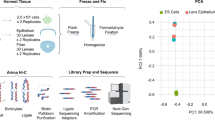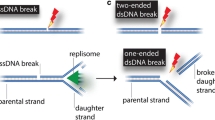Abstract
The DNase I sensitivity of three different chromatin regions in mouse testicular cells was analysed by in situ nick translation with biotin-dUTP combined with various counterstaining techniques. The regions were: (i) the constitutive centromeric heterochromatin, (ii) an interstitial C-band positive insertion on chromosome 1, Is(HSR1;C5)1Lub, and (iii) the chromatin containing rDNA (designated nucleolar chromatin herein). Incorporated biotin was detected either by the horseradish peroxidase reaction with diaminobenzidine (DAB) or the alkaline phosphatase reaction with fast red. The latter resulted in a water insoluble red precipitate, which was easily removable by any organic solution thus allowing the application of various counterstaining protocols. DNase I sensitivity of the three chromatin regions was screened in different cell types of the mouse testis. The interstitial Is(HSR) region was highly DNase I sensitive when it was recognizable by strong mithramycin fluorescence. The centromeric heterochromatin was DNase I resistant when it was compacted into microscopically visible chromosomal structures (mitosis, pachytene, metaphase I and II). In interphase nuclei from Sertoli cells and spermatogonia it became highly DNase I sensitive. In round spermatids it displayed medium DNase I sensitivity. Nucleolar chromatin was not labelled by in situ nick translation when silver staining demonstrated strong protein production. Sperm cells were highly DNase I sensitive from stages 11 to 15, but resistant as mature spermatozoa.
Similar content being viewed by others
References
Adolph S (1988) In situ nick translation distinguishes between Cband positive regions on mouse chromosomes. Chromosoma 96:102–106
Adolph S, Hameister H (1985) In situ nick translation of metaphase chromosome with biotin-labeled d-UTP. Hum Genet 69:117–121
Adolph S, Bartram CR, Hameister H (1987) Mapping of the oncogenes Myc, Sis, and int-1 to the distal part of mouse chromosome 15. Cytogenet Cell Genet 44:65–68
Balhorn R, Weston S, Thomas C, Wyrobek AJ (1984) DNA packaging in mouse spermatids. Exp Cell Res 150:298–308
Comings DE, Kovacs BW, Avelino E, Harris DC (1975) Mechanism of chromosome banding. V Quinacrine banding. Chromosoma 50:111–145
Dixon DK, Burkholder GD (1985) The effects of sodium and magnesium-ion interactions on chromatin structure and solubility. Eur J Cell Biol 36:315–322
Dyer KA, Riley D, Gartler SM (1985) Analysis of inactive X chromosome structure by in situ nick translation. Chromosoma 92:209–213
Evans EP, Breckon G, Ford CE (1964) An air-drying method for meiotic preparations from mammalian testes. Cytogenetics 3:289–294
Feinberg AP, Vogelstein B (1983) A technique of radiolabelling DNA restriction endonuclease fragments to high specific activity. Anal Biochem 132:6–13
Franklin AL, Filion WG (1985) A new technique for retarding fading of fluorescence: DPX-BME. Stain Technol 60:125–135
Gazit B, Cedar H, Lerer J, Voss R (1982) Active genes are sensitive to deoxy-ribonuclease I during metaphase. Science 217:648–650
Goldberg RB, Geremia R, Bruce WR (1977) Histone synthesis and replacement during spermatogenesis in the mouse. Differentia 7:167–180
Gross DS, Garrad WT (1988) Nuclease hypersensitive sites in chromatin. Annu Rev Biochem 57:159–197
Guttenbach M, Schmid M, Jauch A, Vogt P (1989) The Y chromosome of the mouse is decondensed in sertoli cells. Chromosoma 97:429–433
Howell WM, Black DA (1985) Controlled silver-staining of nucleolus organizer regions with a protective colloidal developer: a one step method. Experientia 36:1014–1015
Hutchison N, Weintraub H (1985) Localization of DNase I sensitive sequences to specific regions of interphase nuclei. Cell 43:471–482
Iseki S (1986) DNA strand breaks in rat tissue as detected by in situ nick translation. Exp Cell Res 167:311–326
Jablonka E, Gotein R, Marcus M, Cedar H (1985) DNA hypomethylation causes an increase in DNase-I sensitivity and an advance in the time of replication of the entire inactive X chromosome. Chromosoma 93:152–156
Kerem BS, Gotein R, Richler C, Marcus M, Cedar H (1983) In situ nick translation distinguishes between active and inactive X-chromosome. Nature 304:88–90
Kerem BS, Goitein R, Diamond G, Cedar H, Marcus M (1984) Mapping of DNase-I sensitive regions on mitotic chromosomes. Cell 38:493–499
Kerem BS, Kottusch-Geiseler V, Kalscheuer V, Goitein R, Sperling K, Marcus M (1988) DNase-I sensitivity ofMicrotus agrestis active, inactive and reactivated X chromosomes in mouse-Microtus cell hybrids. Chromosoma 96:227–230
Matsukuma S, Utakoij T (1977) Non-histone protein associated with centromeric heterochromatin in the mouse chromosome. Exp Cell Res 105:217–222
Meistrich ML, Bruce WR, Clermont Y (1973) Cellular composition of fractions of mouse testis cells following velocity sedimentation separation. Exp Cell Res 79:213–227
Murer-Orlando ML, Peterson AC (1985) In situ nick translation of human and mouse chromosomes detected with a biotinylated nucleotide. Exp Cell Res 157:322–334
Oakberg EF (1956) A description of spermiogenesis in the mouse and its use in analysis of the cycle of the seminiferous epithelium and germ cell renewal. Am J Anat 99:391–413
Ponzetto-Zimmerman C, Wolgemuth DJ (1984) Methylation of satellite sequences in mouse spermatogenic and somatic DNA's. Nucleic Acids Res 12:2807–2822
Reeves R (1988) Active chromatin structure. In: Adolph KW (ed) Chromosomes and chromatin, Vol I. Academic Press, New York, pp 109–131
Romanini MGM, Biggiogera M, Formenti D, Fraschini A, Garagna S, Pellicciari C, Redi CA (1986) Sperm-maturation in the mouse. A cytochemical approach. Histochemistry 84:484–491
Sanford J, Forrester L, Chapman V, Chandley A, Hastie N (1984) Methylation pattern of repetitive DNA sequences in germ cells of Mus musculus. Nucleic Acids Res 12:2823–2836
Sperling K, Kerem BS, Gotein R, Kottusch V, Cedar H, Marcus M (1985) DNase-I sensitivity in facultative and constitutive heterochromatin. Chromosoma 93:38–42
Sumner AT (1972) A simple technique for demonstrating centromeric heterochromatin. Exp Cell Res 75:304–306
Thoma F, Sogo JM (1988) Structure of bulk and transcriptional active chromatin revealed by electron microscopy. In: Adolph KW (ed) Chromosomes and chromatin, Vol I. Academic Press, New York, pp 85–107
Traut W, Winking H, Adolph S (1984) An extra segment in chromosome 1 of wildMus musculus: a C-band positive homogeneously staining region. Cytogenet Cell Genet 38:290–297
Weintraub H, Groudine M (1976) Chromosomal subunits in active genes have an altered conformation. Science 193:848–856
Weith A (1985) The fine structure of euchromatin and centromeric heterochromatin inTenebrio molitor chromosomes. Chromosoma 91:287–296
Weith A, Winking H, Brockmann B, Boldyreff B, Traut W (1987) Microclones from a mouse germ line HSR detect amplification and complex rearrangements of DNA sequences. EMBO J 6:1295–1300
Author information
Authors and Affiliations
Rights and permissions
About this article
Cite this article
Adolph, S., Klett, C. & Weith, A. Nonradioactive in situ nick translation combined with counterstaining: Characterization of C-band and silver positive regions in mouse testicular cells. Chromosoma 99, 251–259 (1990). https://doi.org/10.1007/BF01731700
Received:
Revised:
Accepted:
Issue Date:
DOI: https://doi.org/10.1007/BF01731700




